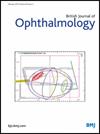呼吁及时预防甲状腺眼病:来自IrTED登记处的经验教训
IF 3.5
2区 医学
Q1 OPHTHALMOLOGY
引用次数: 0
摘要
本研究旨在确定导致甲状腺眼病(TED)延迟识别和治疗的因素,并最终为早期识别需要护理的患者提供建议。方法对2013年3月至2023年3月在德黑兰Rassoul Akram医院登记的伊朗TED (IrTED)患者的回顾性横断面数据进行研究。我们检查了人口统计学、临床活动指数和严重程度以及延迟出现的相关因素。结果685例TED患者的平均诊断年龄为37.79岁。甲亢家族史阳性率分别为37.66%(一级)、10.65%(二级)和10.07%(两者均有)。根据欧洲Graves眼病标准,56.49%为中度至重度,38.10%为轻度,5.40%为威胁视力的TED。59例患者的活动评分为1或2分,但由于最近出现复视或眼球突出而被归为活动。男性有活跃TED的可能性是女性的5倍,有威胁视力TED的可能性是女性的10倍。年龄每增长10岁,TED活跃和TED威胁视力的几率分别增加约72%和96%。考虑到有针对性的干预措施(如戒烟)的潜力,识别甲状腺功能障碍病例的高危亲属可以帮助最大限度地减少疾病进展和相关并发症(一级预防)。男性和老年患者更有可能经历延迟诊断,导致更严重的TED(二级预防)表现。大约四分之一的患者有活跃的TED,需要抗炎治疗。然而,临床活动评分阈值为3没有检测到34.91%的活跃病例(三级预防)。所有与研究相关的数据都包含在文章中或作为补充信息上传。本文章由计算机程序翻译,如有差异,请以英文原文为准。
Call for timely prevention in thyroid eye disease: lessons from the IrTED registry
Background This study aims to determine factors contributing to the delayed identification and treatment of thyroid eye disease (TED) and ultimately provide recommendations for earlier identification of patients in need of care. Methods Retrospective cross-sectional data from patients in the Iranian TED (IrTED) registry, presented to Rassoul Akram Hospital, Tehran (March 2013–2023), were studied. Demographics, clinical indices of activity and severity and factors associated with delayed presentation were examined. Results Among 685 patients with TED, the mean diagnosis age was 37.79 years. A positive family history of thyroid dysfunction was reported by 37.66% (first-degree), 10.65% (second-degree) and 10.07% (both). According to the European Group on Graves’ Orbitopathy criteria, 56.49% had moderate-to-severe, 38.10% had mild, and 5.40% had sight-threatening TED. 59 patients were classified as active due to the recent onset of diplopia or proptosis, despite having an activity score of 1 or 2. Men were five times more likely to have active TED than women and 10-fold more likely to have sight-threatening TED. For every one-decade increase in age, the odds of having active TED and experiencing sight-threatening TED rise by approximately 72% and 96%, respectively. Conclusion Given the potential for targeted interventions such as smoking cessation, identifying high-risk relatives of thyroid dysfunction cases could help minimise disease progression and associated complications (primary prevention). Men and elderly patients are more likely to experience delayed diagnosis, leading to more severe presentations of TED (secondary prevention). Approximately one-fourth of patients had active TED, requiring anti-inflammatory treatment. However, the Clinical Activity Score threshold of 3 did not detect 34.91% of these active cases (tertiary prevention). All data relevant to the study are included in the article or uploaded as supplementary information.
求助全文
通过发布文献求助,成功后即可免费获取论文全文。
去求助
来源期刊
CiteScore
10.30
自引率
2.40%
发文量
213
审稿时长
3-6 weeks
期刊介绍:
The British Journal of Ophthalmology (BJO) is an international peer-reviewed journal for ophthalmologists and visual science specialists. BJO publishes clinical investigations, clinical observations, and clinically relevant laboratory investigations related to ophthalmology. It also provides major reviews and also publishes manuscripts covering regional issues in a global context.

 求助内容:
求助内容: 应助结果提醒方式:
应助结果提醒方式:


